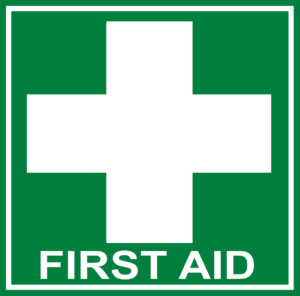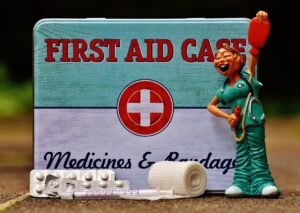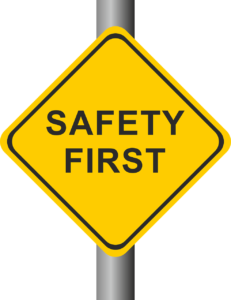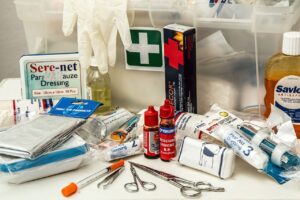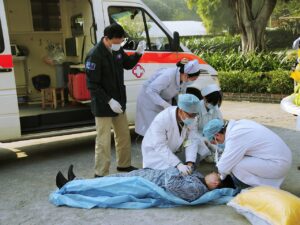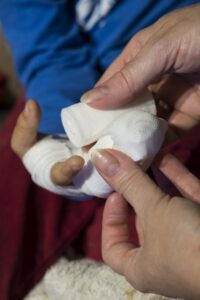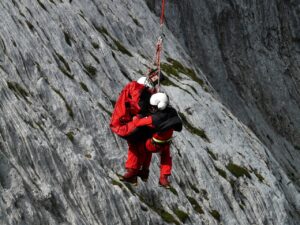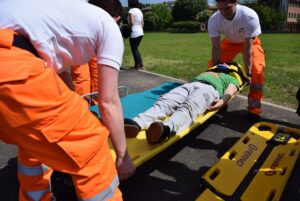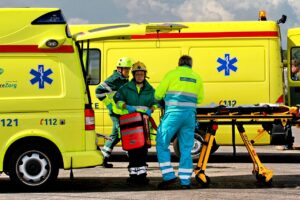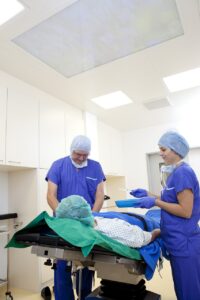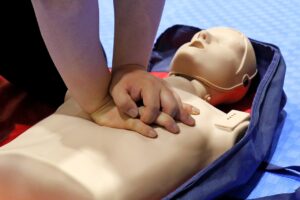First Aid
“Nearly all men die of theirremedies, and not of their illnesses” – Moliere
MOTIVATION
Rewards you may receive by being able to give adequate, efficient first aid assistance to the injured.
-
- LESS INFECTIONS: Proper care given to minor injuries received often prevents serious infections.
- LESS PAIN: You can be an angel of mercy and relieve the suffering and pain of friends and neighbours in a time of need.
- SELF HELP: It is extremely valuable to be able to first aid yourself as well as others.
- SAVE A LIFE: The right action at the proper time following serious accidents that are likely to occur in your neighbourhood can easily save a life.
Standard first aid DIRECTIONS to follow
Some pointers to help you in giving first aid.
PREVENTIVE MAINTENANCE during first aid training
How first aid helps in reducing accidents in your community.
- Keep tools and equipment of home and school in proper order and place.
- Obey traffic signals and use cross walk.
- Check your friend’s bicycles for proper lights for night travel.
- Read labels carefully before taking medicines at home.
EQUIPMENT for first aid kit
How to adequately stock and keep a first aid kit for home and community use. Supply it with the following articles:
- Clinical.
- Sterile roll gauze of different widths.
- Compress bandages.
- Large triangular bandages.
- Rubbing alcohol.
- Burn ointment.
- Merthiolate.
- Iodine.
- Spirits of ammonia.
- Sulfa powder.
- A tourniquet.
- Tweezers.
- Eye dropper.
- Hot water bottle.
- Scissors.
- Epsom salts.
Keep articles well wrapped and clean to prevent contamination.
How to control excessive bleeding during first aid?
Step 1
During first aid process check arterial bleeding by applying pressure on the nearest pressure point between the wound and the heart.
Step 2
Apply a tourniquet between wound and heart if bleeding is severe.
Step 3
Stop venous bleeding by applying pressure or compress bandages on side away from heart.
Step 4
Guard against infecting wounds by touching.
How to treat puncture wound or DEEP WOUNDS?
Step 1
Make the wound bleed freely.
Step 2
Wash the wound with alcohol or disinfectant to clean out dirt and germs.
Step 3
Apply a solution of iodine and allow to dry thoroughly.
Step 4
See that patient procures tetanous antitoxin.
Step 5
Keep wound freely aired.
How to treat cuts and scratches?
Step 1
Clean wound thoroughly with alcohol on cotton.
Step 2
If wound is very light apply coating of merthiolate.
Step 3
Apply sterile bandages carefully (keep fingers free of part covering wound).
How to give first aid to poisonous snake bites?
Step 1
Cut an X mark over bite and draw out blood with a suction cup.
Step 2
Tie a tourniquet between bite and heart.
Step 3
Rush the patient to a physician
Step 4
Guard against shock.
How to first aid a patient suffering gas poisoning?
Step 1
Get the patient into fresh air.
Step 2
Start artificial respiration if breathing has stopped.
Step 3
Give patient mixture of oxygen and carbon dioxide.
How to give first aid to persons suffering injuries of extreme cold i.e., FROST BITE?
Step 1
Gently cover frozen body parts with your hand.
Step 2
Warm affected parts very slowly.
Step 3
Do not rub frozen parts with snow.
Step 4
Give patient warm drinks.
Step 5
Apply extra clothing to affected parts.
How to give first aid to burn injuries?
Step 1
Cover burned surface with sterile gauze or clean cloth compress immersed in warm solution of baking soda (3 table spoonfuls to a quart of water).
Step 2
Treat burns with 5 per cent solution of tannic acid.
Step 3
Treat for shock in serious burn injuries.
Step 4
Treat severe sunburns with a wet dressing of epsom salts.
Step 5
Keep picric acid gauze available in first aid kits.
How to render first aid to broken bone injuries?
Step 1
Treat patient for prevention of shock.
Step 2
Use splints only with extreme care.
Step 3
Give the patient stimulants and keep him comfortable.
Step 4
Apply a tourniquet if arterial bleeding is severe.
Step 5
If bone protrudes treat with iodine and sterile dressing.
How to carry seriously injured person?
Step 1
Seek to move seriously injured persons only in extreme emergencies.
Step 2
Make certain that parts thought to be fractured are properly wrapped with splints.
Step 3
Make stretchers out of cots or blankets on poles for carrying.
Step 4
Keep patient warm.
How to counteract first aid for swallowed poisons?
Step 1
Make patient vomit immediately. Common emetics are soapsuds, salt water, dish water, soda water, etc.
Step 2
Wash out stomach immediately with milk if poison an acid, alkali, or bichloride of mercury.
Step 3
Rush to a doctor.
How to give artificial respiration or CPR during first aid?
Step 1
Place patient on his belly with head resting on one hand.
Step 2
Straddle patient’s thighs and place palm of hand on the small of the back with fingers on ribs.
Step 3
Hold arms straight and swing forward slowly.
Step 4
Swing back and remove pressure completely.
Step 5
Swing forward again after an interval of two seconds.
Step 6
Repeat unhurriedly twelve to fifteen times each minute.
Step 7
Keep steady rhythm until regular breathing returns.
How to apply and use a BLOOD STOPPAGE or tourniquet?
Step 1
Apply tourniquet to digital pressure points.
Step 2
Use a tourniquet only when blood flow cannot be controlled by any other method.
Step 3
Loosen tourniquet every fifteen to twenty minutes.
Step 4
If bleeding continues, tighten tourniquet again.
Step 5
Rush patient to a doctor.
How to handle inflammable and poisonous substances during first aid?
Step 1
Keep all bottles properly labeled.
Step 2
Keep poisonous drugs in separate cabinet out of reach of children.
Step 3
Keep inflammable materials in cool places away from fire.
ACTIVITY ASSIGNMENT:
Laboratory trial performances that aid you in giving timely first aid.
- CLASS WORK: Practice giving appropriate first aid measures for assumed injuries to class member sunder proper supervision and guidance. Get certification here.
- HOME WORK: Administer treatment for imaginary or real (minor) injuries received or likely to be received around your home to family members under parents supervision.
- COMMUNITY WORK: As an active community helper find injured people, animals, or birds and give, or see that they are given, proper treatment.




